When you’re in the market for a reliable Utility Terrain Vehicle (UTV), you’re likely to come across two notable names: the Polaris Ranger and the Kawasaki Mule. Both UTVs are widely recognized for their versatility and durability, making them a common sight on farms, worksites, and trails across the country. They each bring unique strengths to the table, tailored to meet various needs and preferences.
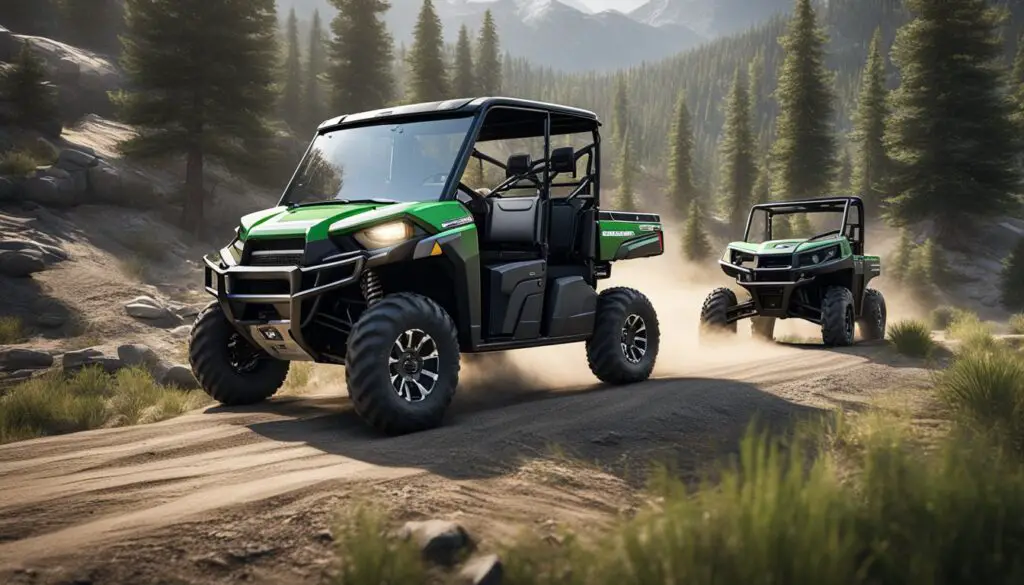
The Polaris Ranger is known for its powerful engine options and impressive towing capacity that can reach up to 2,500 pounds, underlining its capability in both recreational and work-related scenarios. If you’re looking for a vehicle that can haul heavy loads with ease and tackle demanding tasks, the Ranger could be the right choice. This UTV also boasts a range of customizable features, allowing you to tailor it to your specific requirements, whether that’s for work or play.
On the other side, if you prioritize fuel efficiency and passenger comfort, the Kawasaki Mule might suit you better. The Mule’s design focuses on providing ample space, a key consideration if you have plans to transport multiple passengers or carry more supplies. Although its towing capacity may top out at 2,000 pounds, which is lower than the Ranger’s, it stands out for being a sturdy and reliable workhorse that’s built to handle heavy-duty applications with a straightforward approach.
UTV Market Overview
When you’re exploring the market for Utility Task Vehicles (UTVs), you’ll find that brands like Polaris and Kawasaki stand out due to their popularity and range of options that cater to both recreational and utility needs.
Understanding UTVs
UTVs, also known as Utility Task Vehicles or side-by-sides, are versatile, four-wheeled vehicles designed for off-road adventures, practical work tasks, or a mix of both. They typically seat between 2 to 6 people and offer a balance of performance, durability, and cargo capacity. Features to consider include:
- Engine Type & Displacement: Look for terms like 4-stroke twin cylinder or SOHC which indicate the engine’s design and efficiency.
- Towing Capacity: Indicates how much the UTV can pull.
- Fuel Capacity & Efficiency: A larger fuel capacity means longer rides without needing a refill.
Significance of Polaris and Kawasaki Brands
Polaris and Kawasaki are prominent names in the UTV industry. Here’s what sets them apart:
- Polaris: Known for the Ranger model, Polaris offers UTVs with advanced technology and high performance. With a towing capacity of up to 2,500 lbs and engines designed for diverse needs, the Polaris Ranger is a top choice for speed and power enthusiasts.
- Kawasaki: The maker of the Mule focuses on heavy-duty utility. The Mule generally provides more space for passengers and cargo, emphasizing comfort and practicality with a towing capacity reaching 2,000 lbs.
Design and Build Comparison
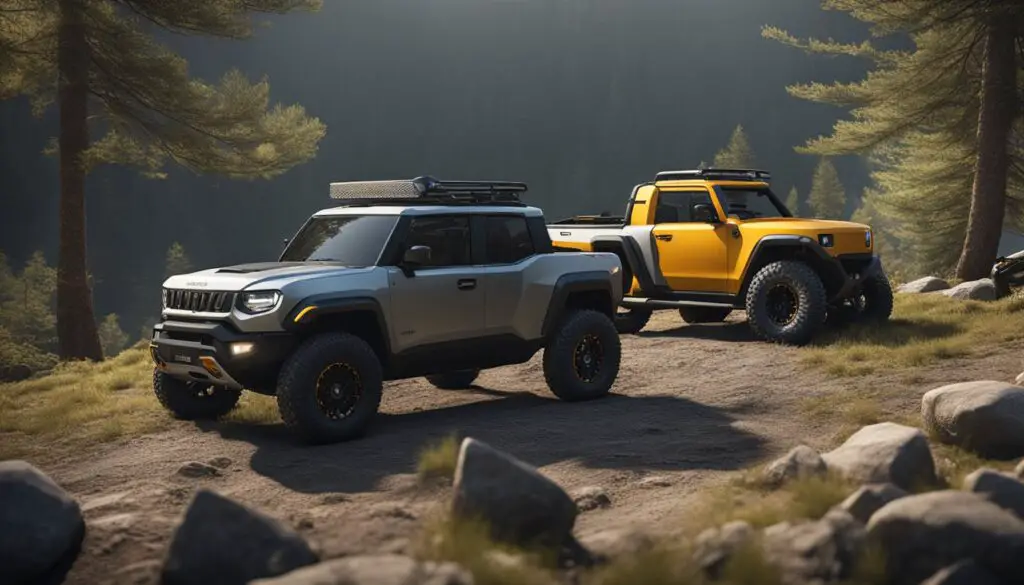
When choosing between the Polaris Ranger and the Kawasaki Mule, your decision may be influenced by the vehicle design and build. This section will help you compare their size and structure, cargo bed capacity, as well as seating and comfort features, so you can see which UTV aligns best with your needs.
Size and Structure
The Polaris Ranger and Kawasaki Mule differ noticeably in size and structure. The Polaris Ranger generally offers a sleeker and sometimes longer chassis, which can affect maneuverability in tight spaces. On the other hand, the Kawasaki Mule is often considered more compact, making it potentially easier to handle, especially in narrower trails or workspaces. You’ll need to measure your commonly used paths to match with the UTV that fits.
- Polaris Ranger
- Larger profile
- Longer wheelbase
- Kawasaki Mule
- More compact design
- Suited for narrower trails
Cargo Bed and Storage Space
When it comes to carrying loads, the cargo bed and storage space are crucial. Both UTVs are designed to haul, but the Polaris Ranger typically offers a larger cargo bed, which is useful for bigger hauls. Moreover, the Ranger’s cargo box design often allows for more accessible storage with features such as a gas-assist dumping bed.
- Polaris Ranger
- Larger cargo bed
- Gas-assist dumping bed
- Kawasaki Mule
- Focused on heavy-duty function
- Durable build for utility tasks
Seating and Comfort Features
Your comfort is important, especially during long hours of riding. The Polaris Ranger is known for having comfortable seating and a quiet in-cab experience with ergonomic designs. In contrast, the Kawasaki Mule places a premium on utility over comfort but still generally provides enough seating space for passengers.
- Polaris Ranger
- Ergonomic seating
- Quieter cab
- Kawasaki Mule
- Functional seating arrangement
- Ample space for passenger comfort
Performance and Capability
When choosing between the Polaris Ranger and the Kawasaki Mule, you’ll want to compare their performance on various fronts such as engine prowess, handling, and their capability to tow and haul.
Engine Specs and Power Output
The Polaris Ranger features a versatile engine lineup designed to cater to both work-focused needs and high-performance demands. The engines can vary in size and power output, with some models providing significant horsepower for more demanding applications. In contrast, the Kawasaki Mule typically offers dependable engines that prioritize consistent performance and durability for various tasks.
Suspension and Handling
Your experience on different terrains will be significantly influenced by the vehicle’s suspension system. The Polaris Ranger is renowned for its smooth suspension, which can handle rough terrain with ease, providing a comfortable ride. The Kawasaki Mule is designed with a robust suspension that aims to provide stability and reliability, especially under heavy loads or when navigating challenging job sites.
Towing and Payload Capacity
When it comes to towing and payload capacity, here’s what you can expect:
- Towing Capacity:
- Polaris Ranger: Up to 2,500 pounds
- Kawasaki Mule: Up to 2,000 pounds
- Payload Capacity:
- Polaris Ranger: Typically around 1,000 pounds
- Kawasaki Mule: Capable of handling approximately 1,600 pounds
Utility and Recreation Uses
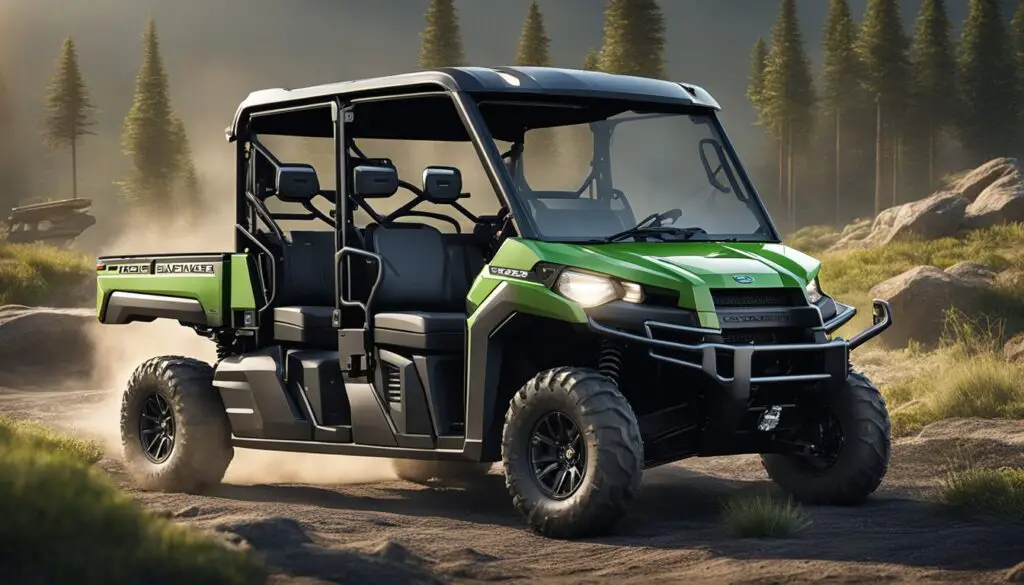
When choosing between the Polaris Ranger and the Kawasaki Mule, consider how each UTV caters to work-related tasks and adventurous outings. The characteristics of these vehicles cater to different needs, ranging from heavy-duty farming to playful trail explorations.
Work-Related Applications
Polaris Ranger: Ideal if you’re a rancher or farmer in need of a robust companion for your day-to-day chores. Here’s what you can expect:
- Towing Capacity: Significant for hauling equipment or feed.
- Payload: Designed to carry hefty supplies without breaking a sweat.
Kawasaki Mule: This UTV serves as your steadfast partner on the job site. With its features tailored for utility, your work efficiency is bound to improve:
- Durability: Built with a tough frame to withstand rigorous use.
- Storage: Ample space for tools ensures you have what you need at hand.
Recreational and Adventure Potential
Polaris Ranger: If you’re pursuing adventures or recreational play, you’ll find its attributes well-suited for excitement and leisure. Explore its potential:
- Speed: Reaches up to 60 mph, adding thrill to your journeys.
- Handling: Agile navigation through narrow trails keeps you in the moment.
Kawasaki Mule: When recreation calls for a leisurely pace and comfort, the Mule paves the way for a relaxed experience:
- Passenger Space: Roomy interiors ensure comfort throughout long rides.
- Stability: Offers steady handling, perfect for leisurely strolls on varying terrain.
Features and Technologies
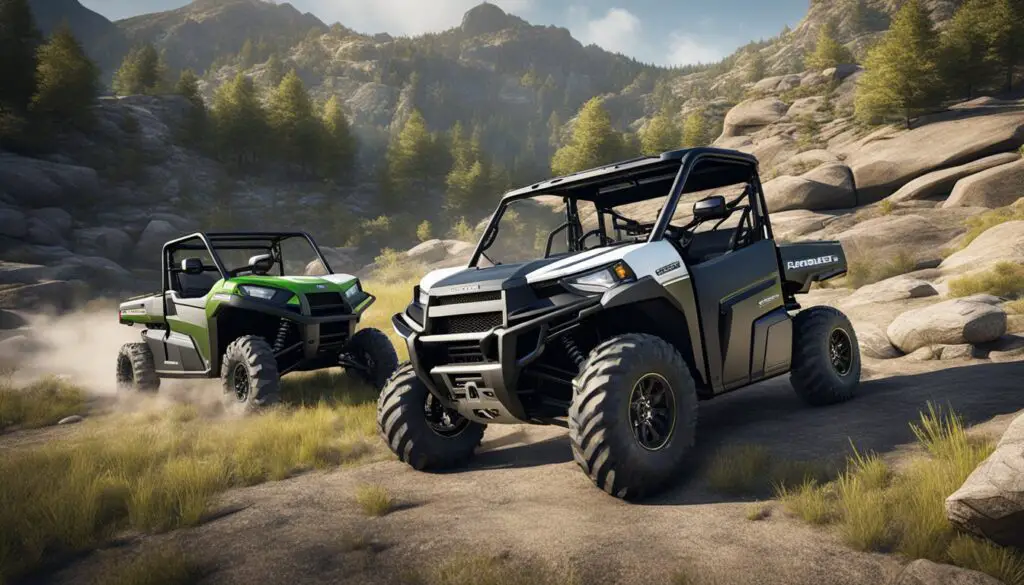
When choosing between the Polaris Ranger and Kawasaki Mule, you’ll find that both UTVs offer a suite of features and technologies designed to enhance your experience. From advanced technology integration that keeps you connected, to user-friendly ride enhancements for a smooth journey, and a variety of accessories for customization, both models deliver unique offerings tailored to your needs.
Advanced Technology Integration
The Polaris Ranger stands out with its available Ride Command technology. This system incorporates:
- GPS Navigation: You’ll have the convenience of a 7-inch glove-touch display that offers GPS mapping and navigation, so you can easily find your way on any trail.
- Smart Connectivity: Connect your smartphone for access to music, calls, and texts without taking your hands off the wheel.
On the other hand, the Kawasaki Mule places focus on dependable technology without as much emphasis on connectivity features.
User-Friendly Ride Enhancements
Your ride comfort and control are paramount, and both UTVs approach this with different features:
- Polaris Ranger: Equipped with adjustable suspension systems to smooth out your ride.
- Kawasaki Mule: Prioritizes utility and functionality, offering a simple operation that can still handle tough jobs and terrain.
Accessories and Customization
Customization is where you can truly make your UTV your own. Here’s how both stack up:
- Polaris Ranger: Offers a wide range of accessories and extra features with both utility and comfort in mind. From additional storage solutions to enhanced audio systems, you can tailor your Polaris Ranger to match your lifestyle.
- Kawasaki Mule: While it might not have as many flashy technology options, the Mule excels in affordability and offers a practical range of accessories focused on enhancing its workhorse capabilities.
Price and Value
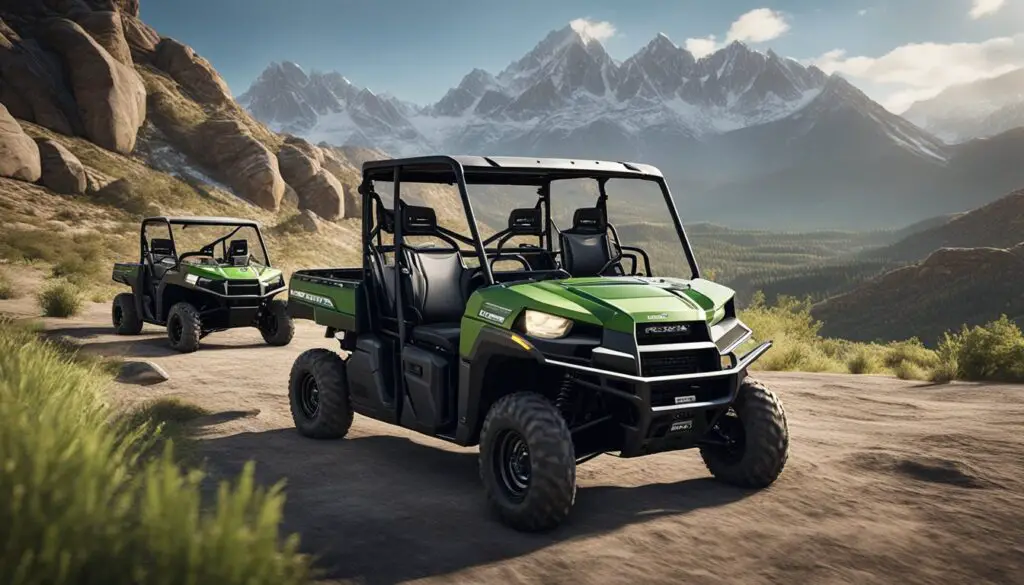
When you’re choosing between the Kawasaki Mule and Polaris Ranger, your budget and the long-term value of your UTV are crucial. It’s important to weigh the initial pricing, ongoing maintenance costs, and support services to ensure you’re getting the best bang for your buck.
Pricing Structure
The MSRP (Manufacturer’s Suggested Retail Price) for the Kawasaki Mule starts at a lower entry point compared to the Polaris Ranger, making it more accessible if your budget is tight. The Polaris Ranger’s lineup includes:
- 5 models under $10,000
- 16 models between $10,000 and $15,000
- 8 models between $15,000 and $20,000
In contrast, Kawasaki Mules often have a starting price that can be more affordable but also have higher-end options that cater to those looking for a more robust feature set.
Cost of Ownership and Maintenance
While the initial price is important, you should also consider the cost of ownership and maintenance. The more powerful engines of the Polaris Ranger might entail higher maintenance costs compared to the Kawasaki Mule, which is known for its simplicity and durability. Regular maintenance costs include:
- Engine servicing
- Tire replacement
- Brake upkeep
Additionally, the frequency of use and the type of terrain you navigate will affect these costs.
Warranty and Dealership Support
Both Polaris and Kawasaki offer competitive warranties that can give you peace of mind. Typically, you’ll find that warranties last for:
- 6 months to 1 year for basic coverage
However, warranty length can vary, so you should check with your local dealership for the specifics of what’s covered. Speaking of dealerships, the network size and the quality of service can be deciding factors. Both brands have extensive dealership networks, but your personal experience may vary based on your location. It’s a good idea to visit local dealerships to get a feel for the level of service and support you can expect after your purchase.
Polaris Ranger vs Kawasaki Mule Model Comparisons
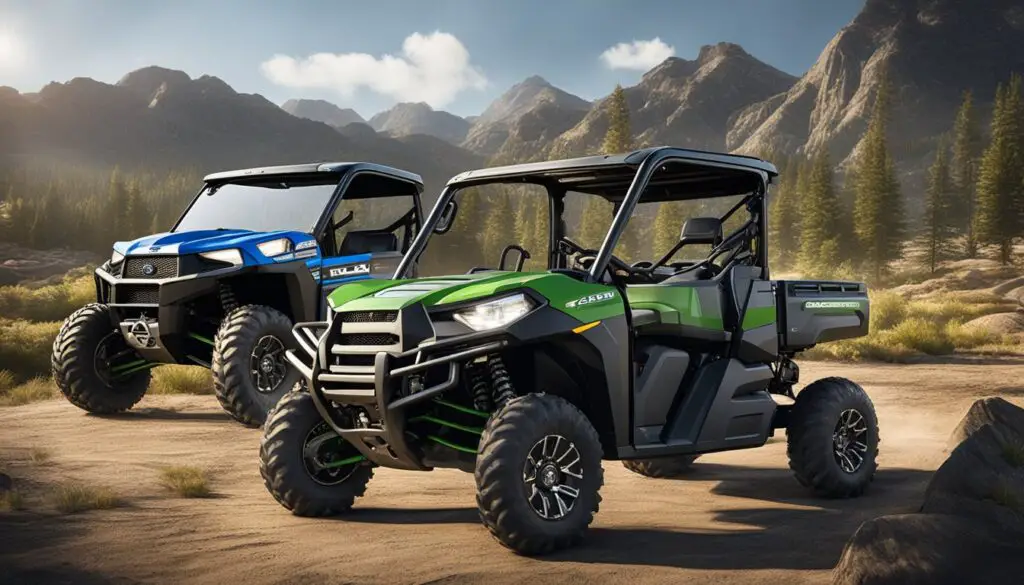
When selecting a utility terrain vehicle (UTV), you’ll find that both the Polaris Ranger and Kawasaki Mule offer a range of models catering to different needs and preferences. You’ll want to consider the lineup from each brand, appreciating the nuances that differentiate them.
Polaris Ranger Lineup
The Polaris Ranger series has been tailored for versatility and performance. Notably, the Ranger 1000 is renowned for its 4-Stroke Twin Cylinder SOHC engine with electronic fuel injection, boasting a displacement of 999cc. If you’re looking for speed, the Ranger is capable of reaching up to 60 mph. The Ranger’s towing capacity stands out as well, capable of towing up to 2500 lbs, which suggests commendable utility for your heavy-duty tasks.
- Engine: 4-Stroke Twin Cylinder SOHC
- Displacement: 999cc
- Top Speed: Up to 60 mph
- Towing Capacity: 2500 lbs
Kawasaki Mule Selection
Turning your attention to the Kawasaki Mule lineup, you will find options such as the Mule PRO-FXT that focus on strength and resilience. Kawasaki’s selection is generally characterized by larger-sized vehicles which may accommodate your needs for space and durability. However, the Mule’s towing capacity typically maxes out at 2000 lbs, slightly less than the Ranger.
- Maximum Towing: 2000 lbs
- Vehicle Size: Larger on average
- Pricing: Ranges to fit various budgets
Comparative Analysis with Other Brands
In your side-by-side comparison, consider brands like Yamaha and Honda to understand where Polaris and Kawasaki stand in the market. For instance, the Yamaha Viking provides another benchmark for comparison in terms of capability and performance. These manufacturers each have unique selling points that cater to different preferences, whether it’s engine performance, price, or specific use-cases. It’s crucial to match the UTV model against your practical requirements, be they for recreational or work purposes.
- Polaris & Kawasaki: Towing and performance-oriented options
- Yamaha & Honda: Competitive brands with unique offerings
- Practical Use-Case Matching: Essential for a satisfying purchase
Consumer Insights and Expert Reviews
In this section, you’ll find a synthesis of user feedback and expert advice on the Polaris Ranger and Kawasaki Mule to help you make an informed decision based on reliability and specific needs.
User Experiences and Reliability Reports
Kawasaki Mule:
- Users report a high level of satisfaction with the Mule’s durability and capability in tough work environments.
- Reliability seems to be a common thread, with many praising its longevity and lower maintenance needs.
Polaris Ranger:
- Enthusiasts appreciate the Ranger’s performance and speed, noting it can reach up to 60 mph.
- There are mixed reviews on reliability, though a notable number of reports suggest it handles heavy loads well with a towing capacity of 2500 lbs.
Professional Opinions and Recommendations
Experts say:
- If your priority is heavy-duty work and you prefer a no-frills, dependable vehicle, specialists often recommend the Kawasaki Mule.
- In contrast, for those of you looking for a UTV with more power and advanced features, experts suggest considering the Polaris Ranger.
In terms of specific needs:
- The Mule’s larger size often comes up as a plus for comfort and cargo space in expert reviews.
- The Ranger’s engine variations and capability of towing heavier loads are highlighted in professional write-ups, making it suitable for a range of activities, from work to recreation.
Frequently Asked Questions
In this section, you’ll find concise answers to some of the common questions regarding the specifications, reliability, pricing, and features of the Polaris Ranger and Kawasaki Mule.
What are the main differences in specifications between the Polaris Ranger and the Kawasaki Mule?
The Polaris Ranger often features powerful engines, like the 1000 model’s 4-Stroke Twin Cylinder SOHC with 999cc, and can hit speeds of up to 60 mph. In contrast, the Kawasaki Mule is known for offering increased space and carrying capacity, though it generally possesses a less powerful engine than the Ranger.
How does the reliability compare between the Polaris Ranger and the Kawasaki Mule?
Both the Polaris Ranger and Kawasaki Mule are recognized for their durability. The Mule is lauded for its robust construction and suitability for heavy-duty work, while the Ranger is noted for its reliable performance in various conditions.
What are the price comparisons for the Polaris Ranger and the Kawasaki Mule when considering a purchase?
In terms of pricing, the Ranger and Mule offer various models that can fit different budgets. For instance, the 2022 Polaris Ranger lineup includes affordable models under $10,000 as well as higher-priced options, while the Mule offers competitive pricing with a focus on utility and simplicity.
When looking at the 2021 models, what sets the Polaris Ranger apart from the Kawasaki Mule?
The key differences for the 2021 models include the Ranger’s high-performance capabilities and advanced tech features. In comparison, the 2021 Kawasaki Mule models prioritize cargo space and passenger comfort.
In terms of features and performance, how do the Polaris Ranger 570 and the Kawasaki Mule stack up against each other?
The Polaris Ranger 570 provides a balance of power and agility, suitable for both work and trail riding. The Kawasaki Mule, while it may not match the Ranger 570 in speed, often provides a more spacious environment and may be better suited for utility-focused tasks.
Which UTV is generally seen as the best value for your money among the Polaris Ranger, Kawasaki Mule, and other competitors?
Value for money can be subjective based on individual needs. The Polaris Ranger line is often praised for its versatility and range of options. It answers the call for both performance and utility. The Kawasaki Mule is typically considered a solid investment for those prioritizing durability and cargo space over speed and thrills.

Leave a Reply